Electric power generation systems: Thermal and Geothermal energy Part II
Electric power generation systems: Thermal and Geothermal energy Part II

Source
The term "geothermal" comes from the Greek geo ("Earth"), and thermos ("heat"); literally "heat of the Earth". The interior of the Earth is hot and the temperature increases with depth. The deep layers are at high temperatures and, often, at that depth, there are water tables in which water is heated: when ascending, hot water or steam produce surface manifestations, such as geysers or hot springs, used for bathrooms since ancient times. Currently, progress in drilling and pumping methods allows geothermal energy to be exploited in many parts of the world.
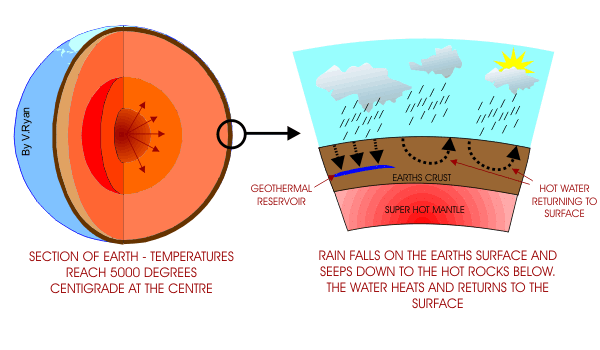
Source
Types of geothermal deposits.

Source
It can be considered that there are three types of geothermal deposits, which could be called:
- Hot water.
- Dry.
- Geysers.
Hot water reservoirs.
There are two types of hot water deposits: the source and the underground. The first ones can be used as thermal baths mixing them a little with cold water to be able to bathe in them but it has the problem of the low flow rates that they have. On the other hand, we have underground aquifers that are reservoirs of water that are at very high temperatures and at a shallow depth. This type of water can be used to extract its internal heat. We can circulate hot water through pumps to take advantage of its heat.
In most cases, the exploitation must be done with two wells (or an even number of wells), so that one gets hot water and the other is injected back into the aquifer, after cooling the flow obtained. The advantages of this system are multiple:
There is less chance of exhausting the thermal reservoir since the re-injected water still contains a significant amount of thermal energy.
The reservoir water is not depleted either since the total amount is maintained.
The possible salts or emissions of gases dissolved in the water do not manifest themselves when circulating in a closed circuit through the pipes, which avoids contamination.
Finally, there are other deposits in which the water comes out in the form of steam. In these, the use is direct to obtain mechanical energy by means of a turbine, but they have the problem that it is more complicated to reinject the water after condensation, and in the way, they will have diffused in the atmosphere a part of the gases that accompany the steam.

Source
Dry sites.
Dry deposits are areas where the rock is dry and very hot. In this type of deposits, there are no fluids carrying geothermal energy or any type of permeable material. It is the specialists who introduce these types of factors in order to transmit the heat. These deposits have a lower yield and a higher production cost.
The drawback of this type of deposits is that the technology and the materials to carry out this practice are still economically unviable, so they are working on its development and improvement. Magma resources offer geothermal energy of very high temperature, but with the existing technology cannot take advantage of these sources economically.
Deposits of geysers.
The geysers are thermal springs that naturally throw columns of steam and hot water. There are very few on the planet. Due to their sensitivity, geysers are found in environments in which their respect and care must be high so as not to make their operation deteriorate.
In order to extract the heat from the geyser deposits, it is necessary to take advantage of its heat directly by means of turbines in order to obtain mechanical energy. The problem with this type of extractions is that the reinjection of the water already at low temperature makes the magmas cool down and causes them to run out. It has also been analyzed that the injection of cold water and the cooling of magmas produce small but frequent earthquakes.

Source
Advantages and disadvantages.

Source
Advantage.
- It is a source that decreases the energy dependence on fossil fuels and other non-renewable resources.
- The waste it produces is minimal and causes less environmental impact than those caused by oil and coal.
- Great savings system, both economic and energetic.
- It does not generate exterior noises.
- Geothermal resources are practically inexhaustible on a human scale.
- It is not subject to international prices, but can always be maintained at national or local prices.
- The area of land required by geothermal plants per megawatt is less than other types of plants. It does not require the construction of dams, nor the cutting down of forests.
- The emission of CO2, with an increase in the greenhouse effect, is lower than that which would be emitted to obtain the same energy by combustion and may become null when the water is reinjected, making it circulate in a closed circuit on the outside.
Disadvantages.
- In microscopic deposits, micro-organisms have sometimes been produced as a result of the sudden cooling of the hot stones, and their consequent cracking.
- Contamination of nearby waters with substances such as arsenic, ammonia, etc.
- Thermal pollution.
- Deterioration of the landscape.
- It cannot be transported (as primary energy) unless it is done with an exchanger and a heat exchanger different from that of the waters of the aquifer.
- It is available only in certain places, except for the one used in the geothermal air conditioning pump, which can be used anywhere on Earth.
Geothermal plant.
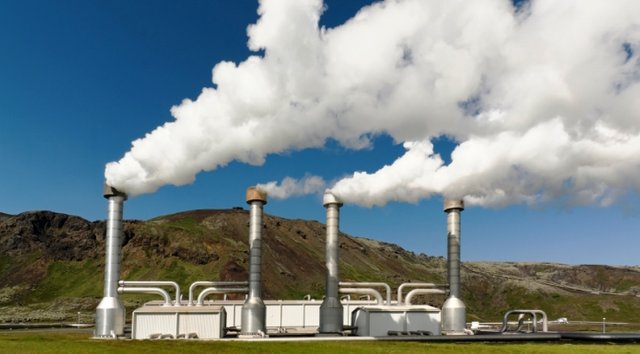
Source
A geothermal plant is a facility where electricity is generated by geothermal energy. Geothermal systems produce a higher performance with respect to other systems and also have a lower maintenance cost. In fact, the only moving part of a geothermal power plant is the turbine-generator system, and therefore the whole assembly has a longer service life. In addition, the energy used is always present, which hardly implies variations, as would happen in other systems that depend, for example, on the flow of a river or on the level of solar radiation.
The operation of a geothermal power plant is quite simple: it consists of a perforation practiced to great depth on the terrestrial crust (about 5 km), in order to obtain a minimum temperature of 150º C, and in which two tubes have been introduced in circuit closed in direct contact with the heat source.
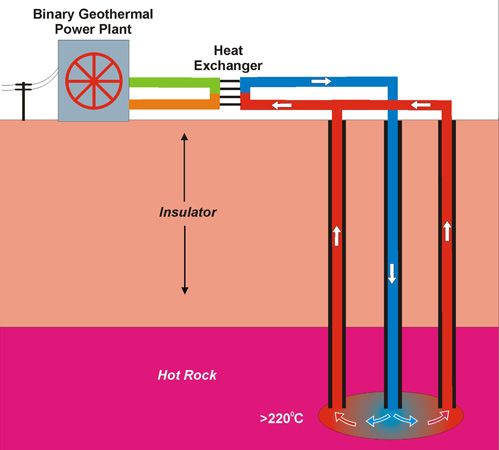
Source
From the surface, cold water is injected through one end of the tube, which is heated to the bottom to form water vapor and returning to the surface through the other tube. At the end of this is coupled a turbine-generator that supplies electrical energy for distribution. The cooled water is returned back inside by the first tube to repeat the cycle.
Despite its simplicity, the system is designed primarily for applications that do not require a large-scale power supply, due to the geothermal characteristics of the rocks. Contrary to what happens with metals, rocks or sand do not have heat conduction capacity, that is, they conserve it, so if a geothermal power plant were used with the intention of producing energy on a large scale, there would come a time when the process would stop. The reason is that the chasm of the interior of the earth's crust where the usable heat is progressively cooling as cold water is injected, and if the rate of injection is high there will come a time when the chasm has given up more heat than can recover, precisely because of its low capacity to drive the temperature. This drawback prevents the continuous operation of the plant, stopping at certain intervals until the rock recovers a sufficient temperature to resume normal operation.
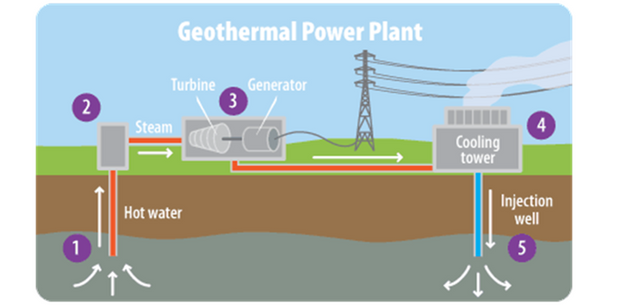
Source
Types of geothermal power plants:

Source
Dry steam power plants.
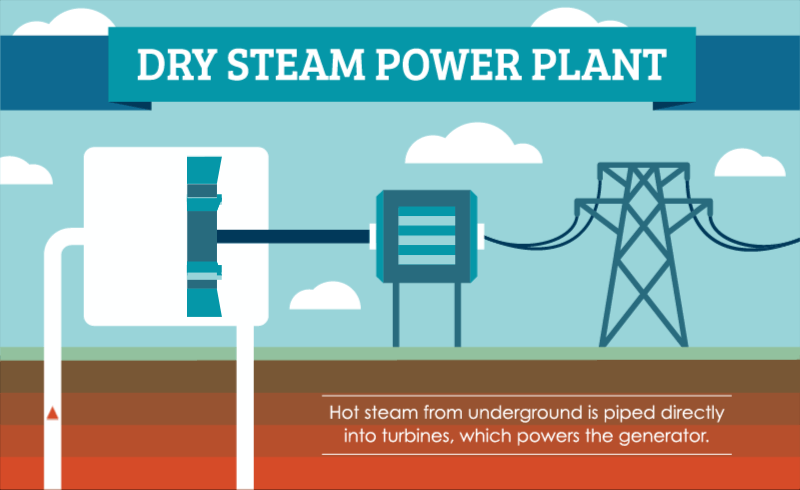
Source
Dry steam power plants are the simplest and oldest design. They directly use geothermal steam at 150 ° C or more to move the turbines. These are pipes that directly transport the hot steam from the geothermal reservoirs to the generators in the power plants, the steam moves a turbine that generates electricity.
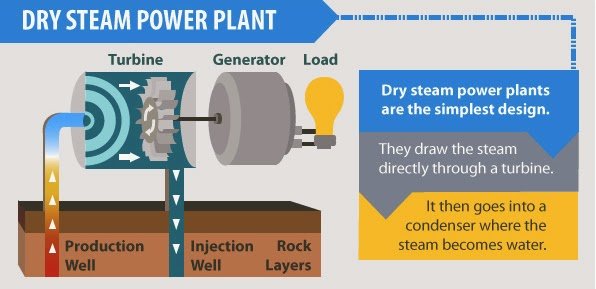
Source
Flash steam power plants.

Source
The flash steam power plants make hot water rise at high pressure through wells and introduce it into low-pressure tanks. By decreasing its pressure, part of the water vaporizes. This vapor is separated from the liquid and used to drive a turbine. The remaining liquid water and condensed steam can be injected into the tanks again, making the process potentially sustainable.

Source
Binary cycle power plants.

Source
In this system, the geothermal water passes through a heat exchanger, where the heat is transferred to a second liquid, which is water at a lower temperature, when this second liquid is heated, the steam that it generates moves the turbine generating energy. Both the Rankine cycle and the Kalina cycle are used. The thermal efficiency of these plants is approximately 10-13%.

Source
For more information you can check:
- https://www.saveonenergy.com/how-geothermal-energy-works/
- http://science.howstuffworks.com/environmental/energy/geothermal-energy.htm
- http://www.eia.gov/energyexplained/index.cfm?page=geothermal_power_plants
- http://geo-energy.org/Basics.aspx
- https://geothermalenergyosu.weebly.com/different-types-of-geothermal-energy.html
- Geothermal Power Plants (1st Edition), Ronald DiPippo.
- Power Generation Technologies, Paul Breeze.
Related posts:


Woow, excellent post !
thanks!
Great post on geothermal power production. SteemOn!
thanks!, I'm glad you like it
Congratulations! This post has been upvoted from the communal account, @minnowsupport, by Ideas-abstractas from the Minnow Support Project. It's a witness project run by aggroed, ausbitbank, teamsteem, theprophet0, someguy123, neoxian, followbtcnews, and netuoso. The goal is to help Steemit grow by supporting Minnows. Please find us at the Peace, Abundance, and Liberty Network (PALnet) Discord Channel. It's a completely public and open space to all members of the Steemit community who voluntarily choose to be there.
If you would like to delegate to the Minnow Support Project you can do so by clicking on the following links: 50SP, 100SP, 250SP, 500SP, 1000SP, 5000SP.
Be sure to leave at least 50SP undelegated on your account.